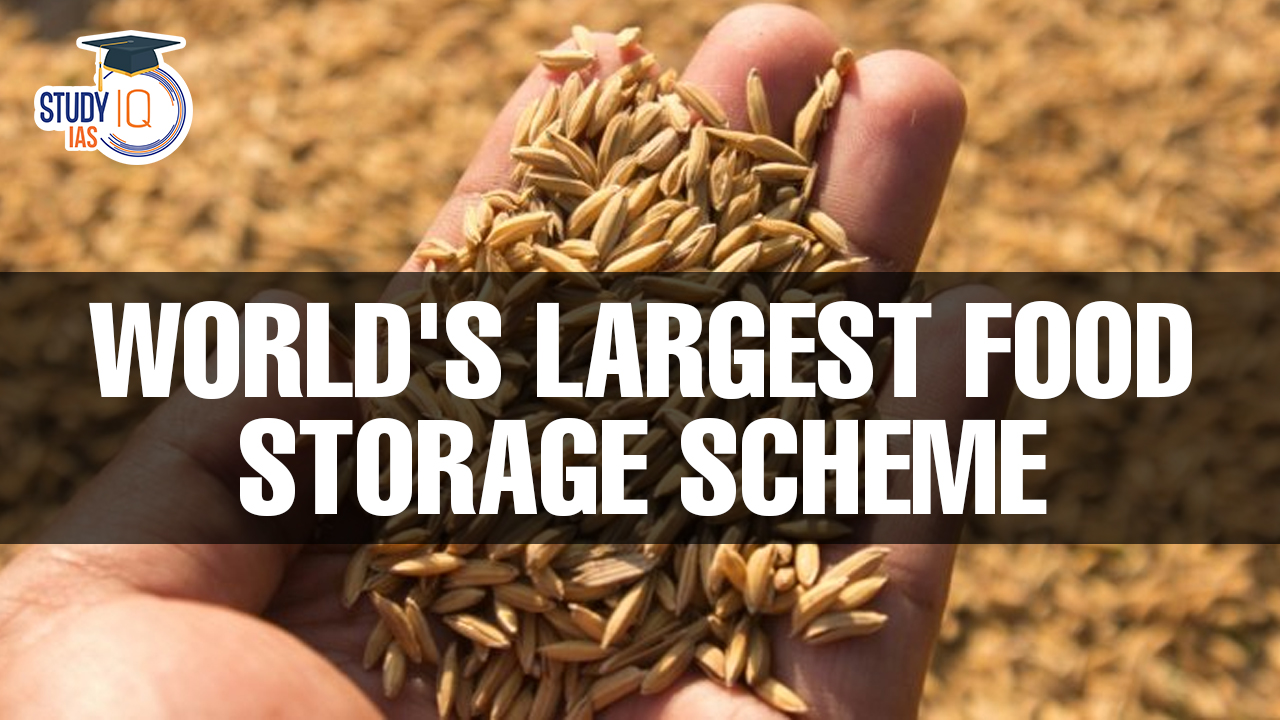Table of Contents
Context: The Union Cabinet of India has approved the Constitution and Empowerment of an Inter-Ministerial Committee (IMC) for Facilitation of “World’s Largest Grain Storage Plan in Cooperative Sector”.
Why Does India Need Grain Storage Scheme?
- High production: India currently produces about 3,100 lakh tonne of food grains a year while the country’s current godown facilities can store only up to 47 % of the produce.
- Additionally, agricultural production is currently being increasingly supported by the minimum support price (MSP) and procurement regime.
- This has created the problem of plenty as India faces challenges in managing this surplus.
- This also leads to post-harvest losses and hampers the efforts to maintain an optimal buffer stock.
- Wastage of foodgrains: Lack of agricultural storage capacity leads to wastage of food grains and farmers are forced to sell their crops at low prices. Inefficient storage structures that are unsuitable for long-term grain storage, lead to spoilage.
- Pest infestation: There is lack of regular cleaning, pest control measures, and repairs in warehouses leading to structural weaknesses and pest infestations.
- Lack of advance technology: There is lack of advanced technologies for storage, such as moisture control systems and temperature regulation, which are essential for maintaining grain quality.
- Low financial allocation for storage: Limited financial resources are allocated for the construction, maintenance, and modernization of storage infrastructure.
Key Points of Grain Storage Scheme
- The new scheme aims to bridge the production and storage gap by significantly increasing storage capacity and reducing wastage.
- The scheme aims to expand foodgrain storage facilities in the country that will boost the cooperative sector.
- With the current grain storage capacity at approximately 1,450 lakh tonnes, this scheme seeks to add 700 lakh tonnes of storage over the next 5 years, eventually reaching a total capacity of 2,150 lakh tonnes.
- Budget: The government will make an allocation of approximately Rs 1 lakh crore for the scheme.
- Methodology: There shall be establishment of godowns with a capacity of 2000 tonnes at the level of Primary Agricultural Credit Societies (PACS) in every block.
- The programme will converge existing infrastructure schemes for which funds have been already allocated.
- Implementation Strategy: Ministry of Cooperation will implement a pilot project in at least 10 selected districts.

What are PACS?
- PACS are village level cooperative credit societies that serve as the last link in a three-tier cooperative credit structure.
- PACS are involved in short term lending (crop loan).
- PACS at the grass root level play an imperative role in transforming the agricultural and rural landscape of Indian economy.
- For farmers, timely access to capital is necessary at the start of their agricultural activities. PACS have the capacity to extend credit with minimal paperwork within a short time.
Significance of Grain Storage Scheme
- Reduce wastage: The creation of decentralized storage capacity at the local level of PACS would reduce food grain wastage and strengthening food security of the country.
- Additional income: Through ‘whole-of-Government’ approach, PACS will be able to diversify their business activities thus enhancing the incomes of the farmers.
- Farmers will get modern grain storage facilities in their blocks through PACS.
- Farmers can store their crops in the warehouses managed by PACS and get finance for the next crop cycle and sell their crops at the time of their choice.
- Farmers can also sell their entire crop to PACS at a minimum support price.
- Better prices for farmers: The scheme would prevent distress sale of crops, thus enabling the farmers to realize better prices for their produce.
- Reduce transport cost: It would hugely reduce the cost incurred in transportation of food grains to procurement centres and again transporting the stocks back from warehouses.
- Reduce import dependence: This scheme will also reduce India’s import dependence and create employment opportunities in rural India.
Way Forward
- Being an agriculture-centric nation, it becomes crucial that India has optimum grain storage facility.
- This grain storage scheme shall prove to be efficient in reducing wastages and cost of handling, besides embedding storage as a part of the agricultural commodity logistics chain.


 India's Crypto Industry in 2025: Massive...
India's Crypto Industry in 2025: Massive...
 BPSC 71st Result 2025 Out at bpsc.bih.ni...
BPSC 71st Result 2025 Out at bpsc.bih.ni...
 Electronics Development Fund (EDF)
Electronics Development Fund (EDF)

























